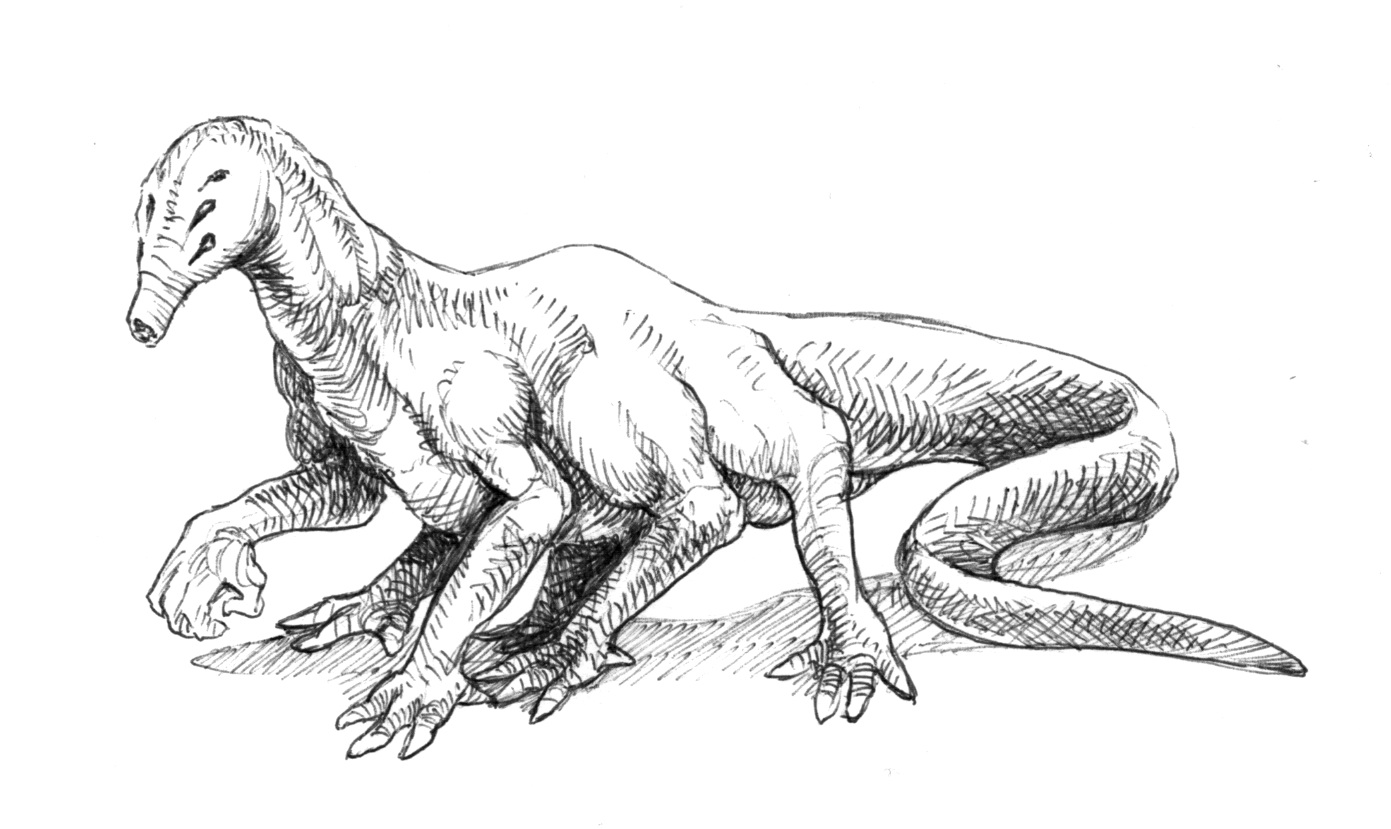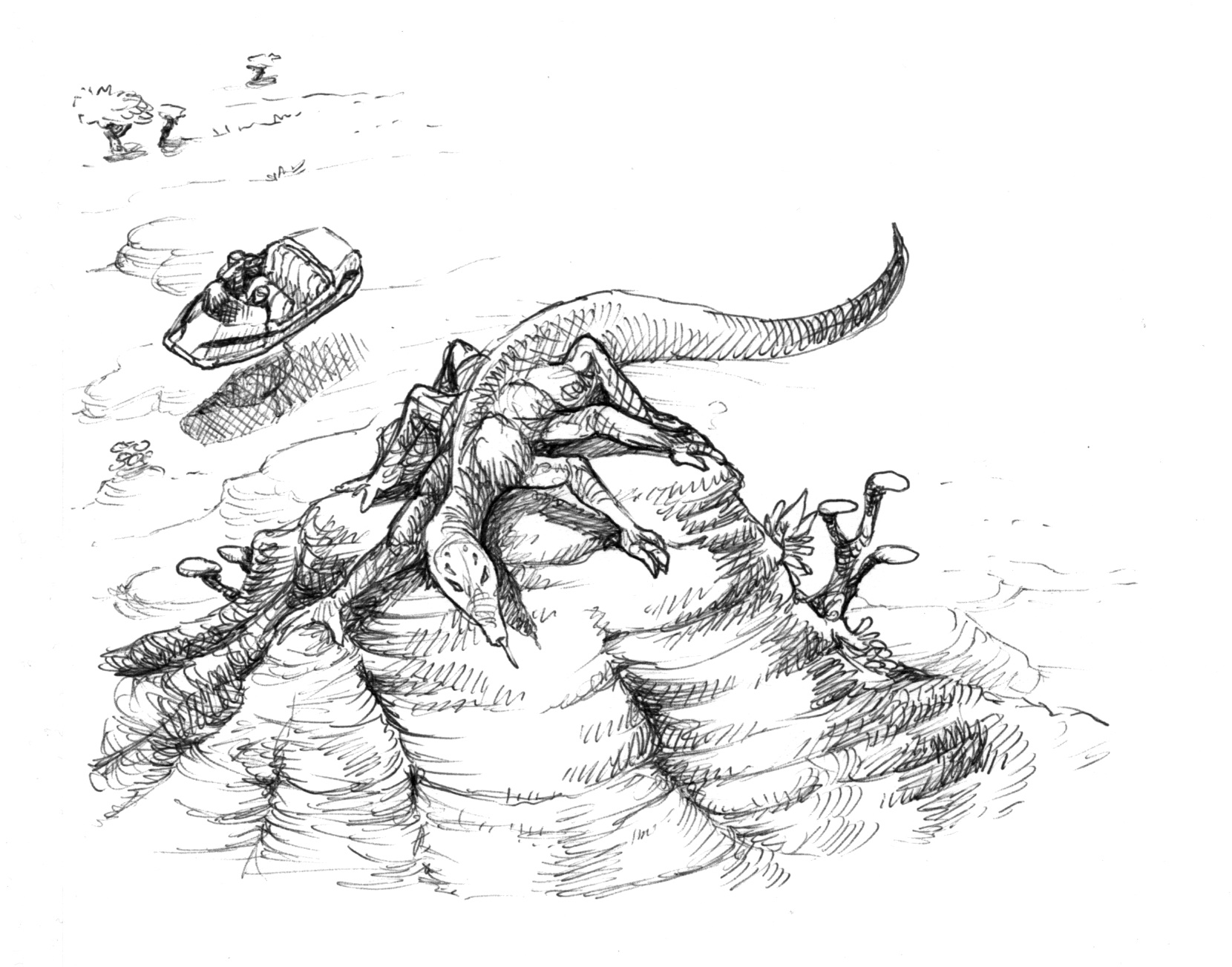Echmerial and Incorial
This article originally appeared in the July/August 2018 issue.
Echmerial
| ANIMAL | HITS | SPEED |
|---|---|---|
| Echmerial | 50 | 10m |
| SKILLS | Recon-2, Athletics(climbing)-2 | |
| ATTACKS | Flee (6-); Attack (10+); Tail slap (3D) | |
| TRAITS | Large (+1) | |
| BEHAVIOUR | Herbivore/Intermittent | |
| Morphology | Bilateral symmetry, hexapod (six long limbs used for locomotion) |
|---|---|
| Biochemistry | C/H/O/N, broadly compatible with human; mammalian |
| Respiration | O2-N2 inhalant; CO2 exhalant |
| Ecology | Diurnal (active during the day) |
| Habitat | Plains, grasslands, steppe, hills, mountains |
| Diet and Trophics | Herbivore/intermittent, endothermic |
| Reproduction | Two genders, little sexual dimorphism, conjugal intercourse, viviparous birth, iteroparous |
| Lifecycle and ontogeny | One year to sexual maturity; lifespan 10-15 years |
Also called a “strider” or “landsnake”.
Gentle-natured, intelligent, curious and easy to train, the echmerial is a favoured riding animal found on many frontier planets. At an overall body length of about three to five meters, nearly half of the creature is taken up by the strong tail which the echmerial uses to keep its balance. An adult weighs about as much as a horse and is very supple, due to a flexible joint and bone structure.
Six semi-faceted eyes form two rows on the skull, providing adequate depth perception, despite the echmerial’s eyesight being below average. The head is shaped like a narrow cone tapering toward a round muzzle lined with rings of blunt teeth, and sits atop a long, flexible neck. Leaves, lichen and ferns, the echmerial’s preferred food, are stripped from branches with a long, sinuous tongue shaped like a needle and set with scales that rasp the food against the teeth as it is pulled into the mouth.. The tongue is also perfectly shaped to enter the tunnels of burrowing insects and dig out the eggs and larvae. Certain insect nymphs and slugs are a cherished treat for them, and are frequently used by handlers as reward snacks.
The six long legs terminate in strong, four-fingered, padded, hand-like palps that afford the echmerial good purchase on difficult ground. Echmerial are moderately good climbers, even when carrying a rider, and can easily negotiate rocky areas and even steep slopes. On level terrain, they are capable of fast turns of speed, but tire quickly if they have to keep up this pace for any length of time. Compared to a Terrestrial horse, their endurance is significantly lower.

When running distances, the echmerial stretches the legs and keeps itself stretched out straight, resulting in a larger silhouette and a higher center of gravity. When aware of danger or traversing difficult terrain, the body drops close to the ground, with the legs spread outward like a spiderīs, and the tail and neck move in serpent-like S-curves. If an echmerial is cornered, it uses its tail to slap an opponent. Human-sized creatures must make a DIFFICULT STR roll to stay on their feet if hit by the sweep of an echmerial’s tail. Even at a full run, an echmerial may jink and use its tail to strike at a pursuer without breaking stride. More often than not, predators are knocked off their feet and lose valuable moments regaining their balance.
Echmerial skin is less than attractive: hairless, whitish and leathery, and constantly covered with a greasy film of sweat protecting it from sunburn and dehydration. Wild echmerial need a temperate climate with at least some humidity, and quickly sicken in the desert, but there are several geneered strains that are hardier and able to survive in arid conditions.
On planets where echmerial are used, general stores carry a variety of protective equipment, ranging from blankets through environmental sandsuits to backpacks containing a miniature evaporator extracting moisture from the air, similar to those used in agriculture on arid worlds. Tribesmen often coat their animals with a herbal mixture that prevents loss of moisture through the skin before embarking on a longer journey.
Echmerial are gregarious and affectionate creatures with an intelligence akin to Terrestrial canines or cockatoos. It is easy to train them, and many riders teach their mounts to perform simple tricks such as counting to five, rolling over or fetching objects. In tribal societies, those tricks are the object of friendly competitions, as they demonstrate the bond of trust between warrior and mount. The echmerial’s intelligence makes it susceptible to boredom, and captive animals must be regularly exercised and entertained, or they quickly develop annoying quirks. Particularly idle animals may gnaw their own extremities or do mischief, and some even learn how to operate the bars on their pens when their keeper is not looking.
Even well-groomed echmerial often forget their training to satisfy their intense curiosity. It takes a trained rider to keep an echmerial’s attention on task. On the positive side, their senses are very keen, and in the wilderness a good rider quickly learns to trust xir mount’s intuition.
Depending on the availability of food, echmerial females may bear young from once a year to once every five years. The young are cared for by the entire herd, with even females that haven’t borne young lactating and providing milk to cubs. A herd ranges from five to fifteen adult individuals, usually two or three males and a higher number of females. Males do not fight for mating rights but rather have contests of speed, zig-zagging blindly across the steppe. Injuries from falling down slopes are not uncommon, as are collisions with other animals in mid-run. Most domesticated echmerial are gelded except those kept for breeding purposes.

Incorial
| ANIMAL | HITS | SPEED |
|---|---|---|
| Incorial | 10 | 10m |
| SKILLS | Recon-3, Athletics(climbing)-4, stealth-1 | |
| ATTACKS | Flee (8-); Attack (10+); Tail slap (1D-2) | |
| TRAITS | Small (-1) | |
| BEHAVIOUR | Herbivore/Intermittent | |
| Morphology | Bilateral symmetry, hexapod (six long limbs used for locomotion) |
|---|---|
| Biochemistry | C/H/O/N, broadly compatible with human; mammalian |
| Respiration | O2-N2 inhalant; CO2 exhalant |
| Ecology | Diurnal (active during the day) |
| Habitat | Forested areas, swamplands |
| Diet and Trophics | Herbivore/intermittent, endothermic |
| Reproduction | Two genders, little sexual dimorphism, conjugal intercourse, viviparous birth, iteroparous |
| Lifecycle and ontogeny | One year to sexual maturity; lifespan 10-15 years |
The echmerial’s smaller cousin shares its temperament and body structure. Incorial are about the size of a small cat and able to climb trees like geckos. They are insatiably curious, and often pilfer shiny objects, carrying them until they lose interest. Incorial are often encountered as a nuisance in forests or jungles, but are trained and kept as pets on some worlds. It is common to see a child with an incorial on xir shoulder, or a climbing habitat for the house pet in a middle-class home. Spacers are also fond of incorial, as they have simple nutritional needs, are intrigued rather than frightened by zero-gee, and enliven a spaceship with their curiosity and antics.
Adventure Seeds
- The travellers are invited to a grand tribal festival. As honoured guests, they are expected to participate in the great echmerial polo tournament. Their opponents are strong warriors who know their mounts in- and outward, but every one of them plays for his own glory. To counter the opponents’ advantages, the travellers must work together as a team to score goals.
- While the travellers are riding their echmerials across the mountainous landscape, one of the mounts behaves strangely. If given free rein, it will take its rider down a rocky crag. On the bottom, they discover the body of a prospector who died of an accident. The corpse still has an ID in its half-decayed jacket. They may wish to contact the family and inform them of their relative’s fate. There is also a map, etched on strange metallic foil and inscribed with characters that look suspiciously like those on Droyne coyns.
- As the travellers camp for the night on a large clearing, curious incorial are drawn to their equipment and try to steal a few pieces.
- During the mating season, the travellers’ ATV is hit by a running pair of male echmerial emerging from the tall grass. The vehicle is unharmed, but both animals are dazed and possibly hurt. The travellers note that one still has the remnants of a riding harness on its neck. What happened to its former master?
- The travellers are hired to transport breeding echmerial to another planet in the hold of their ship, which is converted into a makeshift pen. The animals quickly become bored, and all hands are needed to entertain them. Even so, they appear fond of making mischief for its own sake, nibbling on cables or jumping up and down until the artificial gravity plates are knocked askew.
- An old tribal chieftain approaches the travellers. He mourns the loss of his tribe’s traditions since the Imperial settlers have been setting up their schools and hospitals. Now the cocky young braves of the tribes all ride grav bikes, and the arts of saddlemaking and echmerial training are becoming forgotten. He wants the travellers’ help in organising a great festival, inviting both the settlers and the neighbouring tribes, showing tribal craftsmanship and the ancient arts of echmerial handling and riding, and in this way hopes to rekindle interest in the time-honoured ways of his tribe. While the festival is underway, the travellers notice that someone (a company selling grav bikes) is trying to sabotage the event at every turn.
- A free trader ship is quarantined with the Snow Plague. Unfortunately, the captain’s incorial pet got past the customs officers and is now at large in the highport. The authorities suspect it to be a carrier of the disease. The travellers may be drafted to search for the critter, they may take the search into their own hands (it’s that or spending several weeks detained in port until someone else finds it), or have to stand by helplessly as a workcrew partially dismantles their ship in search of the pet.
 Freelance
Traveller
Freelance
Traveller